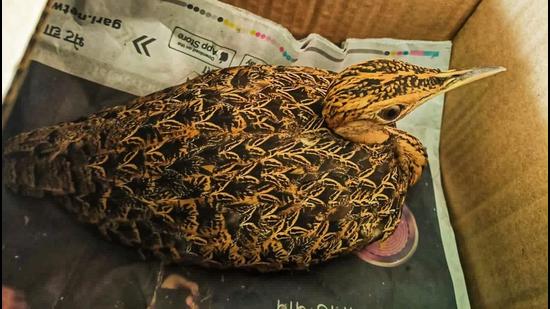Endangered lesser florican rescued in Solapur
A female lesser florican — an endangered species of bustard — was rescued by the forest department in Solapur this week. A female lesser florican — an endangered species— was subsequently tagged with a metal ring and released nearby at the Great Indian Bustard (Maldhok) Bird Sanctuary
A female lesser florican — an endangered species of bustard — was rescued by the forest department in Solapur this week. The bird was subsequently tagged with a metal ring, bearing a unique ID number and released nearby at the Great Indian Bustard (Maldhok) Bird Sanctuary, where officials said, it will have a greater chance of survival. The lesser florican (Sypheotides indicus) is one of three bustard species endemic to India, the others being the Bengal florican and the Great Indian Bustard. Less than 270 lesser floricans are estimated to be alive in the wild.

The sighting of the bird was reported on November 2 by a resident of Nannaj in Solapur North tehsil. He noticed an unusual-looking bird taking shelter near his home to escape a pack of stray dogs, chasing after it. After shooing away the dogs, he informed the nearby Maldhok Sanctuary and the forest department’s office in Nannaj. A team from the Solapur forest department and the NGO Wildlife Conservation Association (WCA) moved the bird to the district veterinary hospital as she had a small injury on her wing.
After examining the bird and administering first aid, the district veterinarian’s office issued a certificate stating that she is fit to be released back into the wild. The bird was released at the bird sanctuary the same afternoon, around 2pm, in the presence of deputy forest conservator Dhairyashil Patil range officer Shubhangi Jawale, as well as WCA members. A female individual of the same species was last seen in Maharashtra in August this year when it was photographed at the Tadoba Andhari Tiger Reserve.
In the local language, the bird is known as ‘tanmor’ on ‘kharmor’, derived from the root word ‘mor’ for peacock, a forest department official explained. “Four years ago, a lesser florican was also seen near the district police headquarters in Solapur. They are an endangered species, but this sighting is important because it tells us they are still present in the area,” said the official, who did not wish to be identified.
A report by the Wildlife Institute of India in 2018 had estimated their remaining population in the wild to be not more than 264 individuals, indicating a decline of about 80% in the last two decades alone.
This species is classified as ‘endangered’ by the International Union for Conservation of Nature and also features in Appendix 2 of the Convention on International Trade in Endangered Species (CITES) which “includes species not necessarily threatened with extinction, but in which trade must be controlled in order to avoid utilization incompatible with their survival.” It is also protected under Schedule 1 of the Indian Wildlife Act.
Kedar Gore, wildlife biologist, director of the Corbett Foundation and member of three separate IUCN commissions, explained that the primary driver for the rapid decline in lesser florican numbers is the disappearance of grasslands and their associated ecosystems.
“Forests in India are better protected, but grasslands are not even seen as having any ecological value. After hunting first drove down the numbers of these birds, their habitat has been under threat in Maharashtra mainly due to the expansion of industries in grassland areas. In Rajasthan and Madhya Pradesh, renewable energy projects have been established on their grasslands, which is where these birds mate. The Corbett Foundation, Bombay Natural History Society, state governments and various experts have been actively working on conservation measures, but there needs to be a wide-ranging policy to arrest the sort of land-use change which is destroying the lesser floricans’ habitat.”



